|
|
The
art of making the most refined and highly esteemed snowshoes of the Mistassini
Cree
VHS, PAL format, DVD: 40 minutes
Henri Vaillancourt
|
Lacing the midsection of a beavertail snowshoe with fancy woven designs , Lac Capichigamau , Quebec, 1985 ; photo Henri Vaillancourt |
|
|
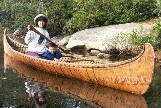 |
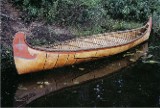 |
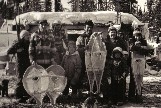 |
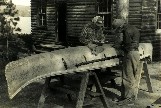 |
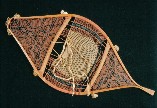 |
| Full size birchbark canoes | Scale model birchbark canoes | Native technology videos and DVDs | Native technology books | |
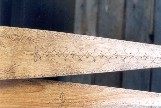 |
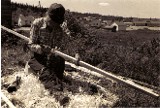 |
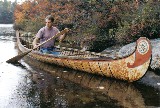 |
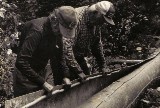 |
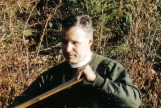 |
| Traditional paddles | Crooked knives | Home |
Materials |
About the builder |
|
The rounded snowshoes of the
Cree, Montagnais and Naskapi Indians of Quebec and Labrador represent one
extreme of Native American snowshoe design. Strong and lightweight -their
shape provides the maximum flotation needed for the light powder snow of
the far north. Their short length (some examples being wider than they are
long) make them well suited for climbing and descending hilly terrain and
for quick maneuvering while doing camp chores or travelling over rough
ground.
The beavertail snowshoe with its tightly bent squarish or rounded tail is the most aesthetic and highly finished of the rounded snowshoe styles. To make a good pair of beavertails requires the consummate skill of a master craftsman and as such these snowshoes are usually highly esteemed by their owners. Beavertails are almost never used as a basic working snowshoe and are often reserved for the traditional hunting of big game, where the hunter pays respect to the animal spirit by "dressing up" for the hunt. In 1977, Sam Rabbitskin, an elderly Cree from Mistassini Lake, Quebec made a pair of beavertail frames suitable for an adult man. From white birch wood, carefully selected for straightness of grain and pliability, he hewed with his axe and then shaved with his crooked knife the four staves that comprised the rim of the frame. The staves were then bent entirely by eye through an astonishing series of steps to achieve the graceful shape of a classic beavertail snowshoe. |
| Beavertail snowshoes with the end sections woven with geometric patterns ; from the video "Beavertail Snowshoes''; photo Henri Vaillancourt 1977 |
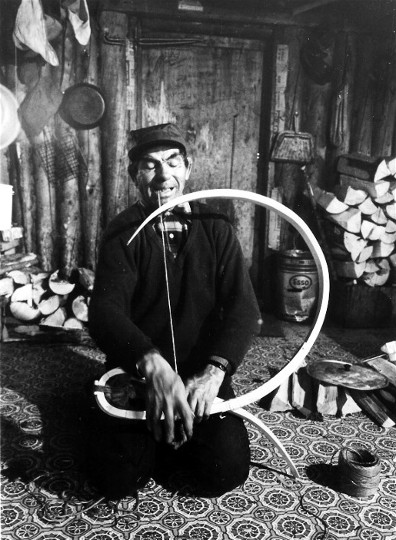 |
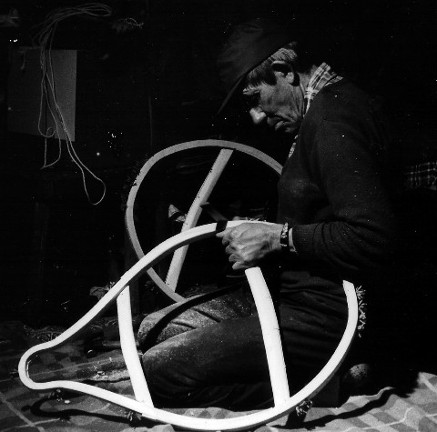 |
| Bending a beavertail snowshoe frame ; Assinica Lake, Quebec ; photo Henri Vaillancourt 1980 | Filing smooth the finished beavertail snowshoe frames; Assinica Lake, Quebec 1980; photo Henri Vaillancourt 1980 |
|
Sarah Bosum, another elderly
resident of Mistassini, laced the frames with carefully prepared string
made from caribou and moose skins. The program depicts the fleshing and
de-hairing of the skins and the final scraping of the frozen skins which
provides the clean white material the Crees are famous for. The skins are
then cut into fine strings which are stretched, tested for strength, and
then woven into the lace-like mesh that privides maximum flotation with
mere ounces of added weight to the snowshoe. Sarah expressed the artistry
of her people in the beautiful geometric patterns that she wove into the
mesh following designs passed down to her by her mother, another expert
weaver. The woven patterns are characteristic of the finest work formerly
done in the Eastern woodlands, but rarely seen today.
Finally, the completed snowshoes were fitted with the traditional moose skin harness and attached to the feet shod in winter moosehide mocassins for an excursion in the forest. |
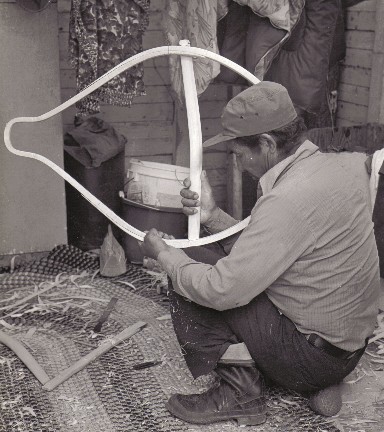 |
|
Sam Rabbitskin installing the crossbars in a new pair of beavertail snowshoes, Mistassini , Quebec 1977; from the video ''Beavertail Snowshoes'' ; photo Henri Vaillancourt |
|
|
More on Beavertail
Snowshoes
|
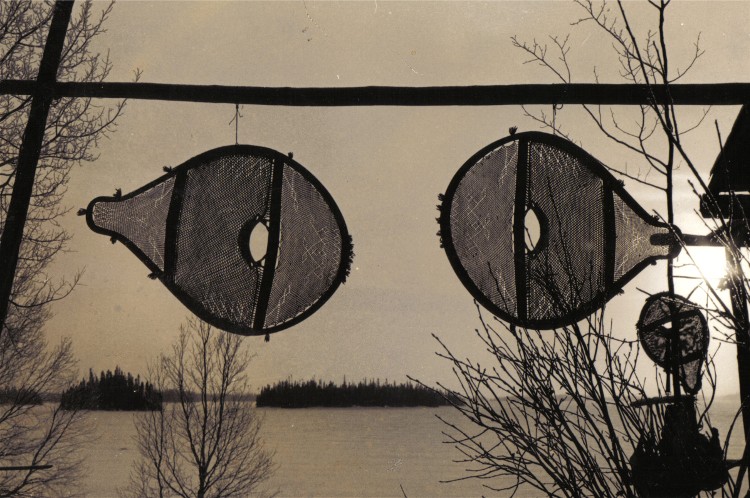 |
| Newly made beavertail snowshoes hung to freeze dry ; Assinica Lake , Quebec , 1980 ;photo Henri Vaillancourt |
|
Beavertail snowshoes, at least among the Cree, are regarded as special snowshoes with spiritual significance.Rarely used as everyday snowshoes, they play an important role , along with the drum , the ''nimaban'' [ ceremonial carrying string made of braided and decorated moose or caribou skin string ] and a few other articles in the spiritual relationdship between the hunter and the animal he seeks.Wearing the beautifully shaped and fancily woven beavertails is just one of the ways the hunter pays respect to imporant game animals such as the moose or caribou.In addition, the hunter would wear clean and often ornamented moccasins and mittens , as well as the white man's tie in recent times, as a way of ''dressing up'' for the hunt. |
| Sarah Bosum painting the woven designs of beavertail snowshoes with red paint to highlight the pattern , Assinica Lake 1980 ; photo Henri Vaillancourt |
|
When not in use, beavertail and other types of snowshoes are hung in a small tree, usually a birch sapling, cut for the purpose and placed in front of the camp. Here they remain displayed as long as the weather is fair. When snow or rain threatens, they are usually taken down and placed in an unheated storage tent to keep them dry . They are never taken in a heated tent , except for brief periods to dry them during wet snow conditions ; in such a case, they are hung from the tent poles well away from the intense heat of the stoves to prevent the woven mesh from being ''burned''.When stored for the season , beavertail snowshoes in particular are wrapped in canvas or other material to keep them clean. The midsection weave of beavertail and other types of snowshoes is often bleached white for aesthetic reasons. This is accomplished by washing the weave with soapy water and then allowing the snowshoes to freeze-dry outdoors.The weave of the toe and tail of the snowshoes is also sometimes treated this way, especially among the Montagnais and Naskapi Indians.The majority of the Cree snowshoes are bleached only in the middle.Care is usually taken , especially with the beavertails, but also with other types as well, to keep the midsection clean and white . To this end , clean moccasins are worn with the better snowshoes; this also serves a more practical end as well , as clean moccasins slip less against the snowshoe,hold the harness better,and provide greater insulation. |
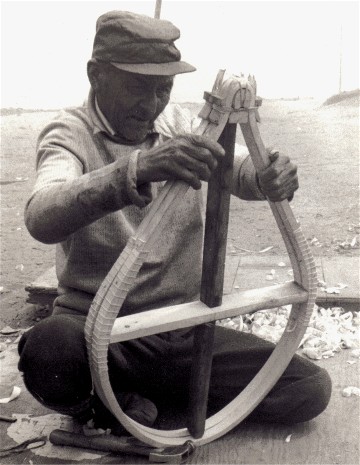 |
|
Newly bent Montagnais beavertail snowshoe frames with an exceptionally tight rounded tail , La Romaine , Quebec 1978; photo Henri Vaillancourt |
|
|
The importance of the snowshoe within the traditional subsistence hunting culture of the Cree would be difficult to overemphasize , for without it life in the frozen North would be impossible.The high regard the people have for this implement, as not just a utilitarian object but an expression of artistry and craftsmanship, is evident in the large number of photos of individuals posing with snowshoes, regardless of their season of use.During his years of research work with the Mistassini Cree in the 1970's and 80's, Henri Vaillancourt saw countless photos taken by the Crees standing with their snowshoes. And when he requested they gather for a group photo, as often as not several would go for their snowshoes before standing to pose. . |
| Installing the selvage cord prior to weaving a pair of Montagnais beavertail snowshoes , La Romaine , Quebec 1978 ; photo Henri Vaillancourt |
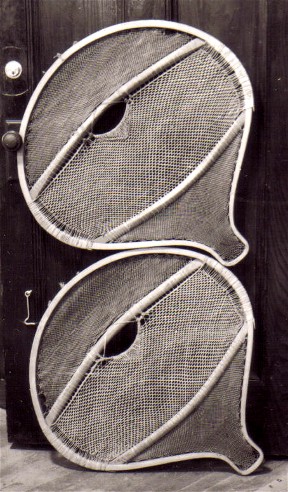 |
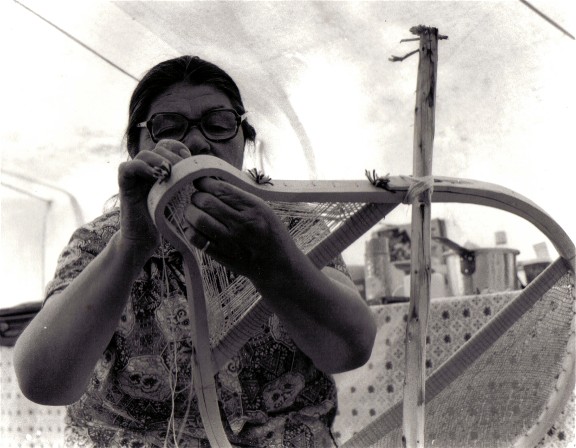 |
| Old Montagnais beavertail snowshoes of an extremely wide pattern in the Chateau de Ramezay , Montreal ; photo Henri Vaillancourt 1973 | Sarah Bosum lacing the tail of a beavertail snowshoe, Mistassini Quebec, 1977 ; photo from the video ''Beavertail Snowshoes '' , Henri Vaillancourt |
[TOP]
For more information not included on this website
email
henri5@birchbarkcanoe.net
phone 603-878-3616
or write Henri Vaillancourt
PO Box 142
Greenville, New Hampshire, 03048